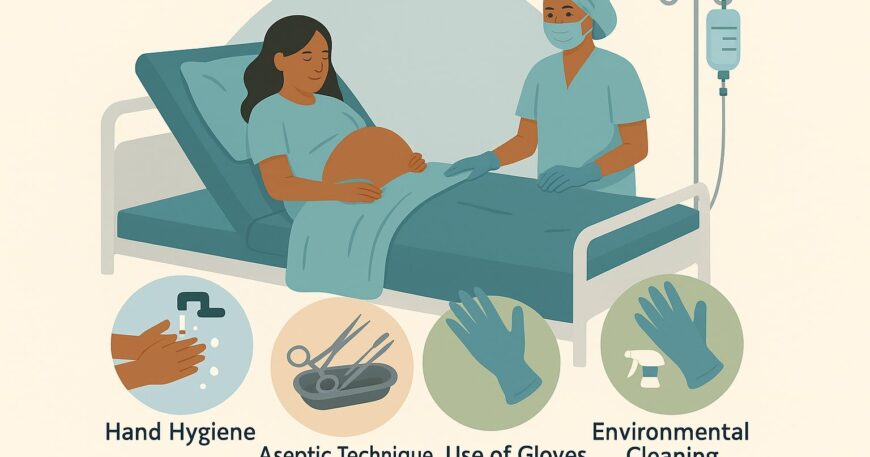
Infection Control in Labour Room: Essential Practices for a Safe Birth Environment
Infection control in labour room environments is a critical part of maternal and neonatal healthcare. In countries like Pakistan, where childbirth-related complications are still common, effective hygiene protocols and equipment use can save lives. When a woman enters a labour room in hospital, she expects safety, professionalism, and a clean environment for delivery. This blog explores the must-follow practices and tools involved in infection prevention during childbirth.
Infection control in labour room environments is a critical part of maternal and neonatal healthcare. In countries like Pakistan, where childbirth-related complications are still common, effective hygiene protocols and equipment use can save lives. When a woman enters a labour room in hospital, she expects safety, professionalism, and a clean environment for delivery. This blog explores the must-follow practices and tools involved in infection prevention during childbirth.
Why Infection Control Is So Important
Infections during childbirth can lead to serious complications for both the mother and the newborn. According to the World Health Organization (WHO), nearly 10% of maternal deaths worldwide are caused by sepsis, many of which are preventable with proper infection control.
A safe birth environment requires:
- Clean and sterilized labour room instruments
- Proper use of labour room equipments
- Correct administration of drugs used in labour room
- Routine training and implementation of updated guidelines for labour room hygiene
What Makes a Labour Room in a Hospital High-Risk?
Labour rooms are high-contact zones where multiple procedures—such as vaginal exams, episiotomies, and drug administration—are performed. If infection control in labour room settings is not prioritized, bacteria and viruses can spread quickly.
The presence of bodily fluids, use of sharp tools, and high turnover of patients make these areas particularly vulnerable. Hospitals must therefore ensure a well-designed infection control program backed by modern equipment in labour room setups.
Key Tools and Equipment in Labour Room That Support Infection Control
1. Sterile Labour Room Instruments
Sterilized scissors, clamps, forceps, and delivery trays are essential. These labour room instruments names may sound simple, but they must be autoclaved before every use to prevent contamination.
2. Disposable Kits
Many hospitals now use single-use delivery kits that include gloves, gowns, masks, and drapes. These reduce the risk of cross-contamination between patients and healthcare providers.
3. Sanitation and Waste Disposal Units
Proper bins for sharps, bodily fluids, and other waste help avoid infections. Equipment in the labour room should include color-coded containers to ensure safe disposal.
4. Infant Resuscitation Equipment
Newborns are at high risk of infection, especially if born prematurely. Special warmers, suction machines, and sterile instruments are used immediately after birth to ensure a hygienic start to life.
Guidelines for Labour Room Hygiene and Sterility
Every hospital should follow national and international guidelines for labour room infection control. These include:
- WHO Safe Childbirth Checklist
- ACOG (American College of Obstetricians and Gynecologists) protocols
- Pakistan’s Ministry of National Health Services regulations
Some best practices include:
- Washing hands thoroughly before and after every procedure
- Wearing protective gear such as gloves and aprons
- Ensuring that floors and surfaces are cleaned with hospital-grade disinfectants
The Role of Drugs Used in Labour Room in Infection Prevention
Medication also plays a vital role in infection control in labour room settings. Commonly used drugs include:
- Antibiotics to prevent or treat infections
- Oxytocin to induce labour and reduce postpartum bleeding
- Antiseptics like chlorhexidine for skin cleaning before procedures
These drugs must be administered in sterile environments and under professional supervision.
Training and Monitoring: The Human Side of Infection Control
Even the best equipment in labour room setups cannot guarantee safety if staff are not trained properly. Regular training sessions ensure that everyone—from doctors to nurses—follows hygiene protocols.
Moreover, monitoring tools like checklists and audits help evaluate compliance. Infection control officers often review practices and suggest improvements to maintain safety.
Infection Control in Labour Room: A Closer Look at Shaafi Hospital
Shaafi Hospital Alipur is one of the leading names in maternal care in Pakistan. Their labour room in hospital setup is aligned with global standards. They focus on cleanliness, updated labour room equipment, proper staff training, and use of certified labour room instruments names.
The hospital also ensures the correct administration of drugs used in labour room cases and maintains an excellent record in infection prevention.
Real Facts That Emphasize Its Importance
- According to the Pakistan Maternal Health Survey 2022, infection-related complications account for over 18% of postnatal readmissions.
- WHO reports that hospitals with high hygiene ratings see up to 70% fewer maternal infections.
These facts show that good infection control in labour room practices is not just optional—it’s essential.
Final Thoughts
Infection control in labour room settings is a joint effort that requires trained staff, clean environments, and the right tools. From sterilized labour room instruments names to well-followed guidelines for labour room practices, each element plays a role in safeguarding the lives of both mother and child.
Hospitals that prioritize hygiene and safety, like Shaafi Alipur, set a strong example in maternal healthcare. When all protocols are followed, the labour room becomes a place of healing, not risk.
Sources
- World Health Organization – Infection Prevention and Control Guidelines
- Pakistan Maternal Health Survey, 2022
- ACOG Clinical Guidelines on Labour Room Safety
FAQS
Q1: What is infection control in the labour room and why is it important?
Infection control refers to all the steps taken to prevent infections during delivery, including sterilization, hygiene protocols, and safe medication use. It helps protect both the mother and baby from serious health risks.
Q2: Which tools are used for infection control during childbirth?
Sterile instruments, disposable kits, color-coded waste bins, infant care equipment, and cleaning supplies are key tools used in the labour room to ensure a safe environment.
Q3: What guidelines do hospitals follow to maintain hygiene in the labour room?
Hospitals follow WHO guidelines, ACOG protocols, and national healthcare standards. These include handwashing, use of PPE, sterilization, and waste management.
Q4: Can infections be prevented completely in the labour room?
While not all infections can be avoided, strict infection control practices reduce the risk significantly—by up to 70% according to WHO.
Q5: Does Shaafi Hospital Alipur follow infection control standards?
Yes, Shaafi Hospital Alipur follows international best practices, uses sterilized equipment, and trains its staff regularly to maintain a high standard of cleanliness and safety.
CTA
Choose Safe Delivery with Shaafi Hospital Alipur
Looking for a hospital that puts safety and hygiene first? At Shaafi Alipur, we ensure every birth takes place in a sanitized, fully equipped labour room following the highest standards of infection control.
Book your consultation today and let us make your childbirth journey safe and worry-free.
📞 Call us: 051 2615517 / 0345 5005033
🌐 Visit: https://shaafihospital.pk/
